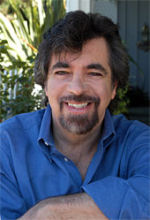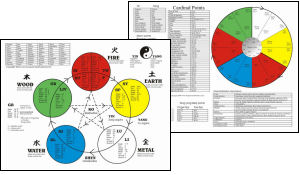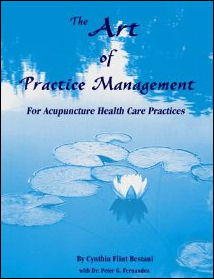Acupuncture & TCM Articles

Neil R. Gumenick is the founder and Director of The Institute of Classical Five-Element Acupuncture. Neil is a Worsley certified advanced teacher of Classical Five-Element Acupuncture and a practitioner with over 27 years of private practice experience. Neil holds three degrees from the College of Traditional Acupuncture (U.K.), and he participated for 10 years in the Master Apprentice Programô, led by Profs. J.R. & J.B. Worsley. Neil has taught at the USC and UCLA Schools of Medicine, the Worsley Institute of Classical Acupuncture, the Traditional Acupuncture Foundation, California Acupuncture College, Santa Barbara College of Oriental Medicine, and Pacific College of Oriental Medicine. He has been a Professor at Emperor's College of Traditional Oriental Medicine and SAMRA University of Oriental Medicine. Neil is co-author of The Art of Practice Management for Acupuncture Health Care Practices
The Initial Consultation: Getting to the Heart of the Matter, Part 2
By Neil Gumenick, MAc (UK), LAc, Dipl. Ac
The initial consultation is where it all begins.
It provides us with an opportunity to learn who our patient is and what they need in order to be whole and healthy in body, mind and spirit. Every area we explore, even the most seemingly simple such as, "Where do you live?" or "What do you do for a living?" can provide us with a wealth of information if we are attentive to the clues we are given and know how to ask the right questions. Regardless of the style of medicine we practice, gaining the patient's trust and having a rapport will go a long way toward refining our diagnosis, accuracy of treatment, ensuring patient compliance, retention, payment for services and referrals.
Before the Patient Enters
One of the first clues occurs before the patient even walks through our door. Noticing how they move, from exiting their vehicle to making their way to our door. For this reason, I have my office on the ground floor with a view of the parking lot.

On more than one occasion, I have seen a patient in obvious physical or emotional distress in the parking lot suddenly put on a brave (and false) face once inside. Conversely, I have seen patients appear to be quite normal outside and suddenly manifest visible symptoms once aware of being seen. One patient hides pain while another exaggerates it. Some patients pull their appearance together before entering, while others seem quite unconcerned about such matters. The vehicle a patient drives, their clothes and accessories, their state of hygiene and much more, can give us valuable information about the person we are about to see.
It is rather like the great fictional detective, Sherlock Holmes, who could deduce so much about a person's identity without ever asking a single question, to the constant amazement of his faithful comrade, Dr. Watson, who would protest that he could see nothing. Holmes admonished Watson by reminding him that he could, in fact, see everything, but failed to reason from what he saw.
No single manifestation of appearance or behavior, on its own, will necessarily give us a person's diagnosis. However such information, when woven together with the sensory input (odor, color, sound and emotion) gleaned during the initial examination, may well give us more knowledge and insight about our patients than they have about themselves.
The Initial Contact
Often, the first physical contact we make (customary in the West) is a handshake. In addition to noting the temperature, texture, moisture and other physical characteristics of the hand, we can note how a person makes this greeting. It often says far more than words could ever convey. The person may say, "Nice to meet you," but the handshake can deliver a very different (and often more truthful) message, perhaps saying quite clearly, "Stay away. Keep your distance." Alternatively, the handshake may be very shaky and tentative, revealing fear and vulnerability. Some patients grasp our hands and hold on as if for dear life, as if to say, "Hold me. Please don't let me go." Some handshakes are lifeless and dead, perhaps expressing the state of the energy within. Others try to crush our hands with great strength, leading us to wonder why such a show of force is necessary. The facial expression must also be observed. Does it match the message being given through the hand? Are these messages consistent with the spoken words and the tone of the voice?
The Patient's Name
Often, the patient's first spoken word to us is their name. One's name usually is one's principal identity. How people express their identity says much about how they feel about themselves, who and what they believe themselves to be. "Hey, I'm John," said warmly and casually, is very different from, "Hello, I am Mr. Jones," said with precise formality. Both expressions give us clues about who each perceives himself to be and how we need to be, in order to have a rapport with each. There need be no judgment here - we are merely observing.
The Patient's Address
The question, "Where do you live?" can evoke a tremendous wealth of information. Where a person lives can be a source of pride, comfort, security, joy, shame, frustration and a host of other emotions. How the patient answers is the key. The response, "Oh, I live in Los Angeles," gives a very different message than, "I live at 123 Main Street, third house from the corner. It's a two-story, grey house with white trim. My wife just put the most beautiful red roses on the terrace in front. We really must have you over soon." In the first case, we might question as to why the patient chooses his whereabouts to be a mystery and impossible to locate. In the second, we note a familiarity and desire for a relationship beyond the professional setting (inappropriate, at this stage) that is similarly discordant. In either case, as well as many other possible responses, we can use the given information to go deeper with our questioning and get to the issues unique to the patient seeking our aid. Without knowing who the patient is in depth, we cannot address the depth of his or her needs with our treatment.
A Case Study
Early in the course of an initial examination, I asked a patient where she lived. She rattled off her address in an unexpectedly angry tone. The question was benign enough, yet the tone of her answer triggered my curiosity to question deeper. I remarked that she sounded a bit upset and asked if she liked living where she did. She replied that she did not like it, that she had only been there six months, had made no friends, and had been, essentially, forced to relocate by her husband's transfer at work. She was now thousands of miles away from her family and friends and resented the entire experience. She went on to say how she and her husband had been fighting since the move and, within a month of the move, her presenting symptoms of headaches began.
I took her hand and gently asked her if her husband was aware of how she felt. At this gesture of compassion, the "floodgates" opened and, amidst her tears, she replied, "No, he doesn't understand. No one does." This revealed to me the essence of her issue, in its depth. It was, for me, what my teacher of nearly 25 years, Professor J.R. Worsley, called a "golden key." Her facade was, for the moment, stripped away -
her mask lowered, and her true feelings revealed. Beneath the anger was a woman who felt she was abandoned, on her own, and that no one cared or understood. This, combined with the yellow color lateral to her eyes, fragrant odor, a singing quality to her voice (which sounded like pleading), and a continual need for sympathy (present also in every subsequent area of inquiry) confirmed her primary elemental imbalance, or causative factor, as Earth.
Among the qualities of the Earth element are the abilities to nurture and care for oneself and others and to be at home wherever one is. A healthy Earth element provides the security of knowing that one always is at the breast of Mother Earth, who provides the abundance of a full harvest, comfort and sustenance at all levels. This patient was spiritually starving and disconnected, hence her desperate need for sympathy and understanding.
Often, practitioners perceive a patient's presenting emotion and reason, "She's angry. She must be Wood," and leave it at that. In this patient's case, the anger was appropriate to the situation. What I felt, in her presence, was the need to give sympathy, to which she strongly responded. My job was to search for the clues that revealed what she was feeling deeper than the surface anger and resentment. Understanding a patient's underlying thoughts and feelings - the heart of the matter - depends on the depth of our investigation. If our investigation is shallow, our findings similarly will be one-dimensional. If we investigate deeply, we will be astounded by the excitement of an initial examination and the findings that we can uncover.
The following were among the points that I chose during the course of the patient's treatments. They were not done as part of the first treatments, but when the patient's Earth had been sufficiently strengthened by first using command points, predominantly (source points, horary points, transfers, etc.). The following points do not constitute any type of formula for either headaches or homesickness, as the causes always are unique to the individual. I describe their spiritual connotations to illustrate how, once having perceived the needs of an individual patient, using appropriate points on the elemental causative factor meridians are the response to those needs.
Stomach 21 Bridge Gate
This point implies transition and crossing into new territory. If this gate is closed, one becomes stuck and cannot move forward; the stomach official cannot smoothly digest or draw sustenance from new experiences if one cannot enter into them, being so identified and attached to the past. Though acupuncture could not, obviously, turn back the hands of time and return this patient to her former home, this point enabled her to unlock, open the gate and cross the bridge into a whole new source of sustenance.
Stomach 23 Great Oneness
Like a baby at the breast of its mother, there is a unity, with no sense of separation between self and other. The baby is full and content, receiving everything it needs from its mother. Similarly, when we are in the state of great oneness, we can draw sustenance and learn from everything and everyone we experience. This point helped return the patient to her own center, which she had always carried within her, but had forgotten. Even in the midst of change, when we are centered within, we can flow with change, be enriched by the experience and, like a good mother, share of our abundance with others.
Spleen 4 Prince's Grandson
This point brings the internal certainty and security of a future harvest. Clearly, this patient felt that she had neither future nor harvest on the horizon. In Chinese mythology, the 12 organs/functions, which we call officials, were seen as ministers of the Imperial Court. The prince was the son of the King, who owned and ruled over the land, which provided the bounty. The King was responsible for its conservation and wise use, fairly distributing its rewards and harvests to all of his people. It was the job of the King to train his son so that when he inherited the land, the people would prosper from future harvests. The prince eventually would teach his son, and so on through the generations. Thus, this point helped this patient to see her situation with new hope, seeing that in her own future, there was no scarcity, but the promise of abundant fullness and fruition.
 
The Art of Practice Management for Acupuncture Health Care Practices
What you will find in this book is a specific, comprehensive approach that gets to the root cause of success in practice.
This new book presents acupuncture practice as art from the standpoint of centering, qi, and wholeness. It builds on the premise that practices succeed from bridging inner and outer aspects of the self. It is an inquiry into the self and addresses clear understandings and approaches to reputable patient care and practice qi. It brings in the five elements and work with the seasons of practice from training and start-up to growth, stability, expansion and transformation. The authors artfully bridges the essence of both patient and practitioner well-being without excluding the practicalities of financial well-being. This book very specifically and extensively shows how the different parts of practice nourish and feed one another and are interdependent on one another for the qi to flow synchronistically.
It explores the dual nature of procedures that work and those which do not in acupuncture health care practice, returning again and again to the delicate balance of practicality and spirituality.
|
